

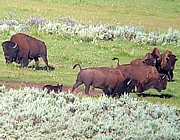
Blinding white rock cascades at Mammoth Hot Springs, impressive geysers, and a morning spotting wildlife in the Lamar Valley that we'll never forget.
See also SW Yellowstone & SE Yellowstone
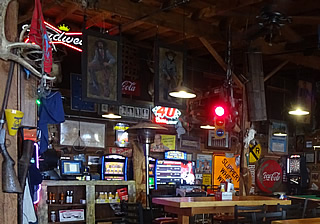
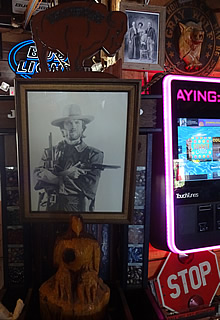
We drove through Yellowstone to spend two nights at Gardiner, specifically so that we could go on an early morning wildlife excursion.
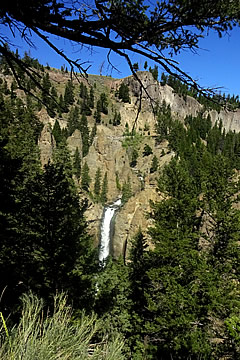
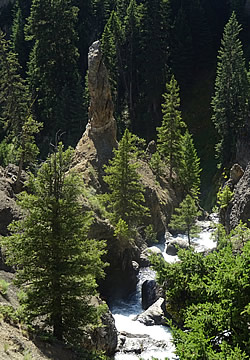
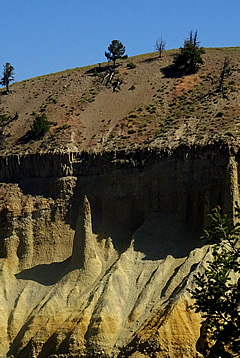
Gardiner is a nice place to stay, we were in the Yellowstone Gateway Inn which we really liked. We had a huge suite of rooms with a fully functioning kitchen and tvs with dvd players to take advantage of the large collection at reception. We did this on both nights we stayed there, after tiring days in the park. Just across the road is the excellent Coral where we got superb elk and bison burgers and fries to take back to the room to eat while watching a film - cans of Czechmate from the liquor store just down the road - we'd discovered the beer in the Iron Horse bar in town, overlooking the river. It's an atmospheric place, stuffed to the gills with memorabilia and with some good beers on offer.
We drove the "nerve-wracking" (guide book description!) Dunraven Pass but we barely noticed it. Apparently visitors from the flatter parts of the US have some difficulty on this road.
On the way to Gardiner we stopped to take a look at 40m high Tower Fall and the rock pinnacles above the Yellowstone River for which it is named - nice but not spectacular.
Just north of Tower Fall is Calcite Springs overlook. Calcite Springs was named for the milky-white crystals that cover the area, interspersed with honey-coloured barite crystals. Within the hot conduits of the springs are yellow sulphur crystals.
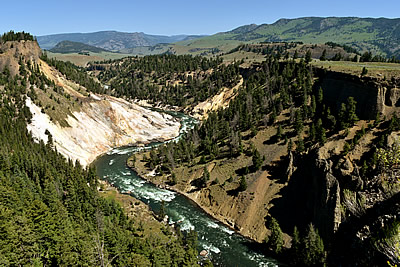
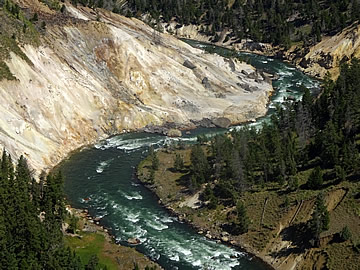
The heat deep underground releases oil which slowly seeps to the surface; according to the information board occasionally molten sulphur reaches the surface too, where it turns black on contact with air, but not sure what this would be, mostly sulphur manifests as yellow crystals.
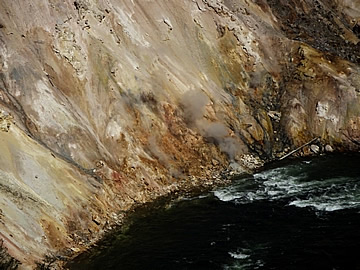
We had planned to do a short hike to an overlook closer to the springs but the trail was exposed and it was extremely hot so we abandoned that idea.
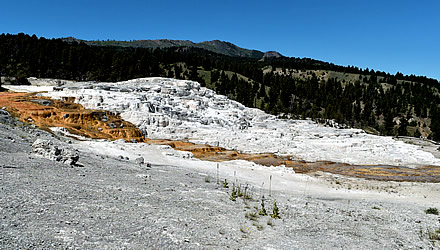
Mammoth Hot Springs are very close to the North Entrance to the park at Gardiner. The first time we visited it was terrifically hot so we cut our visit short and returned another day.
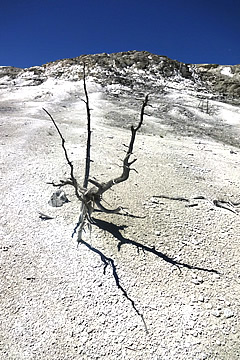
This area has some of the most stunning rock landscapes and hot pools in all of Yellowstone. Mammoth is a series of blindingly white terraces, created from the calcite deposits of heated water rising from deep underground - the resultant gleaming rock surface is travertine, a form of limestone.
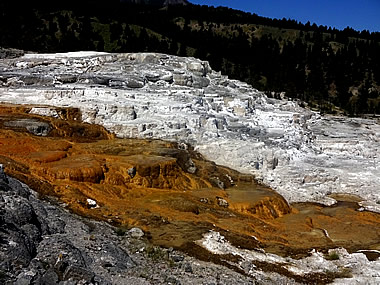
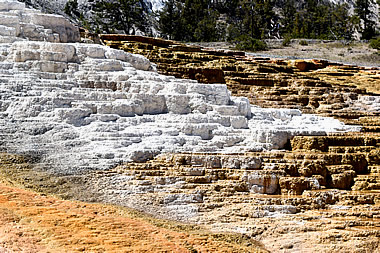
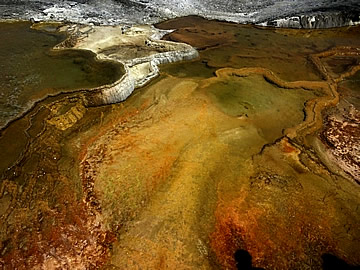
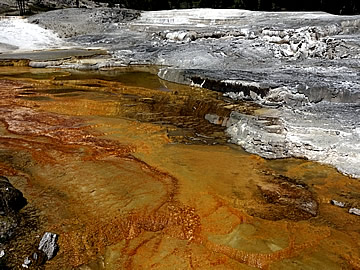
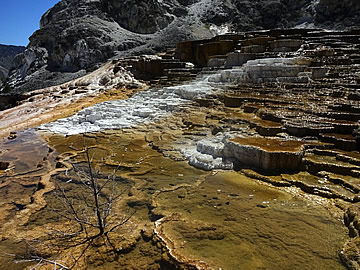
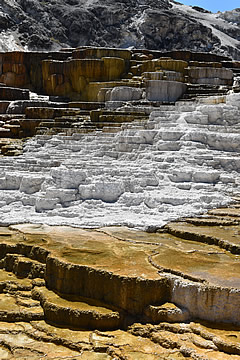
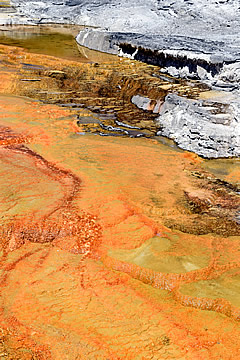
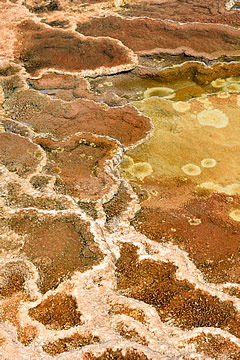
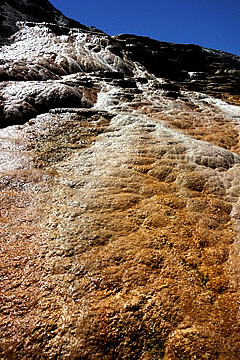
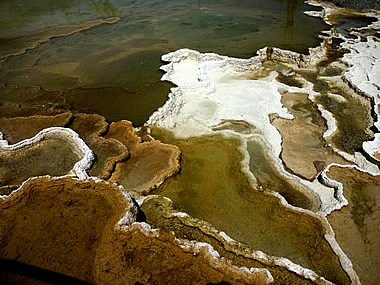
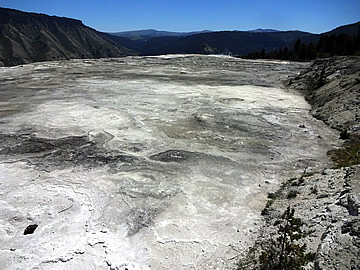
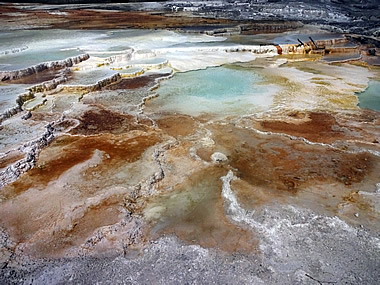
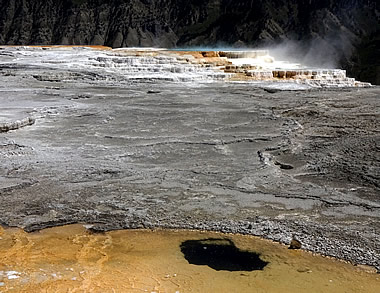
It's quite a hike from the lower parking lots around Main Terrace to Canary Spring so worth choosing a cooler, less crowded time if you can.
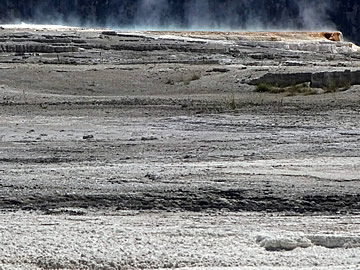
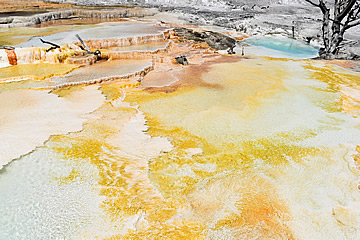
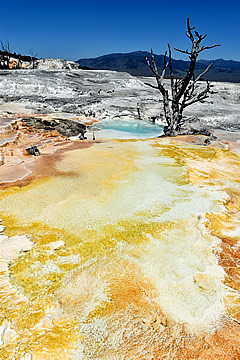
Canary Spring is the highlight of this area, a gleaming cascade of white travertine terraces and steaming hot pools.
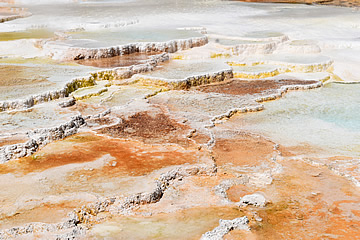
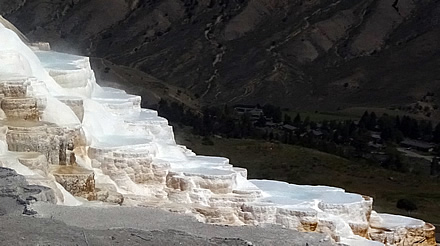
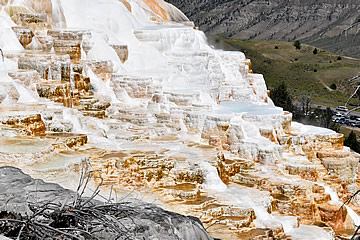
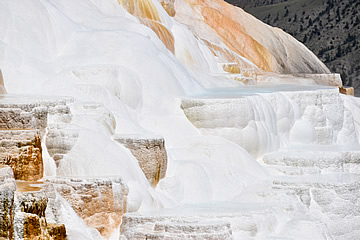
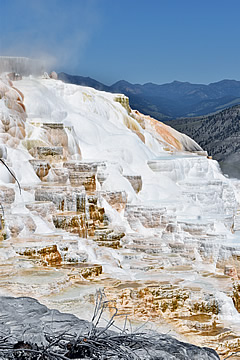
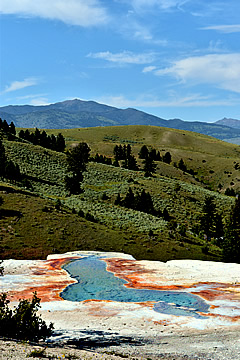
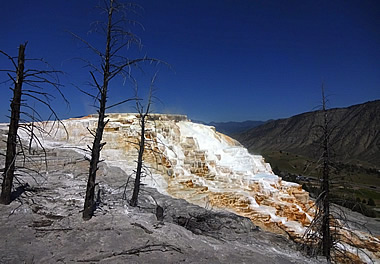
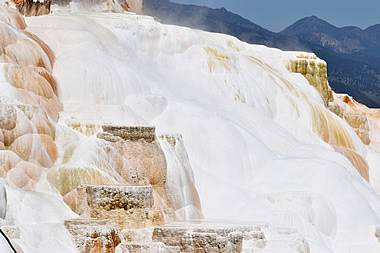
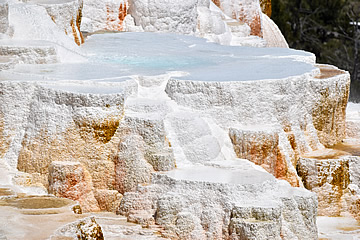
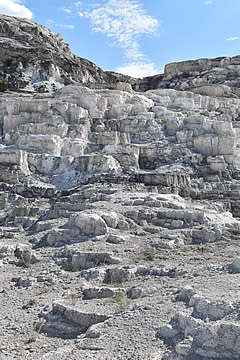
This is as far as we got on our first visit to Mammoth Springs - it was unbelievably hot and we called it a day to head into Gardiner. When we returned we explored the lower terraces in the northern section - nice but not as spectacular as Canary Spring.
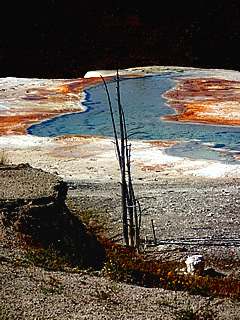
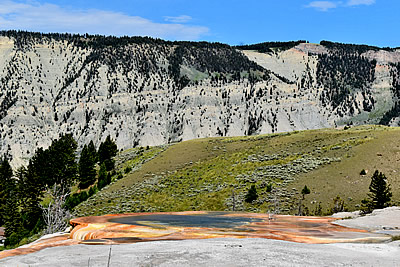
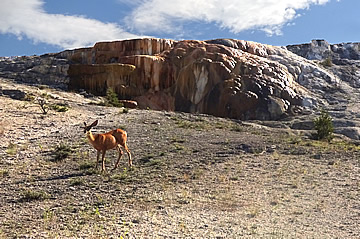
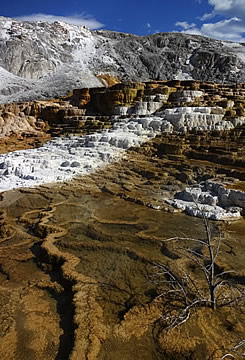
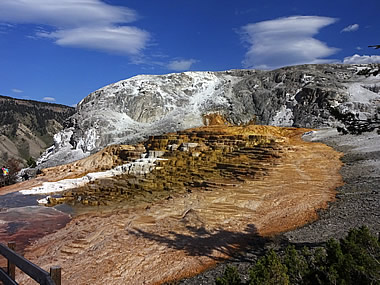
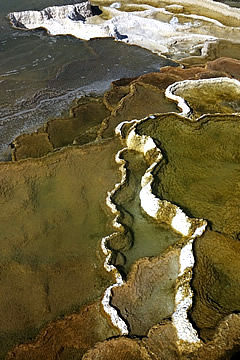
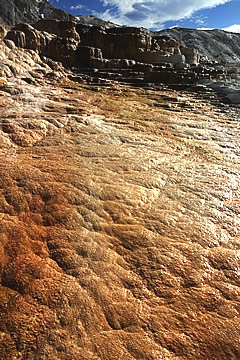

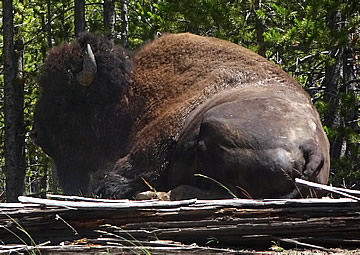
Norris Geyser Basin is Yellowstone's hottest geyser basin. Here things change frequently as the Basin undergoes "thermal episodes" when many geysers and hot springs are altered: water levels fluctuate and temperatures may rise or fall, trees die as there roots experience extreme heat, geysers can become murky rather than clear and eruptions may vary more than usual. These "thermal disturbances" usually last around a few weeks.
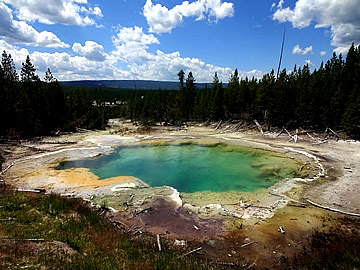
We only explored the northern half of the area, missing out the southern section which has more geysers, springs and steam vents.
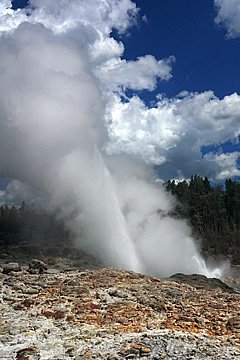
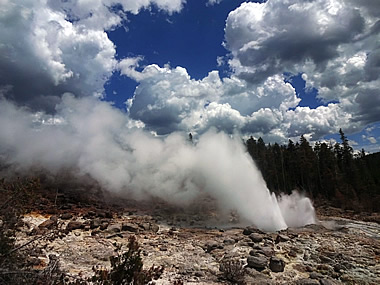
We had come primarily to see Steamboat Geyser and were mightily impressed - we though it much more dramatic than Old Faithful. It was almost continually erupting in spouts up to maybe 12m high. It is, however, the world's tallest active geyser with unpredictable, infrequent eruptions reaching more than 91m.
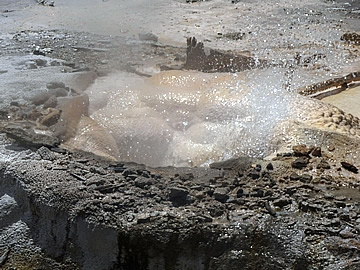
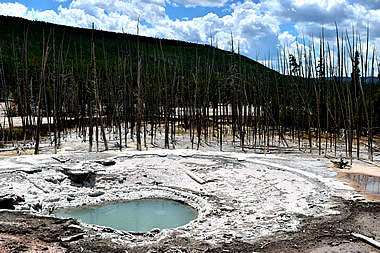

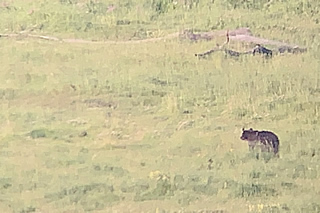
The undisputed highlight of our visit to Yellowstone was the morning we spent with Lianna of Yellowstone Wolf Tracker. We saw more wildlife than we though possible including wolves and bears.
Lianna arrived prompt at 5a.m. and we headed to the north entrance of the park close to Gardiner and then east. There was a huge herd of elk on both sides of the road as we drove in the pitch black, Lianna was very alert to the wildlife. She headed straight for a spot where a buffalo carcase was lying about half a mile from the road - there were a number of other spotters here, all with powerful scopes.
Lianna had brought three scopes with her and set them up for us, 60x magnification which made viewing the feeding animals so easy. The buffalo had died a natural death a couple of days earlier and the carcase was a magnate for wildlife. We saw a grizzly bear just leaving, taking his time ambling back up into the trees. Two wolves fed at the carcase for a very long time. They tore and ripped the flesh from the bones with their teeth, at times we could smell the carcase.
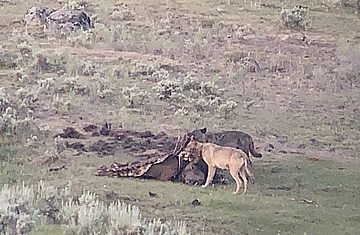
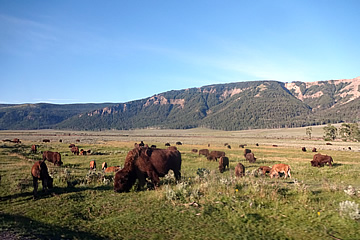
Lianna could fit her mobile onto one of the scopes and she took photos and videos which she passed on to us later, giving permission to use them - all the videos here are from her.
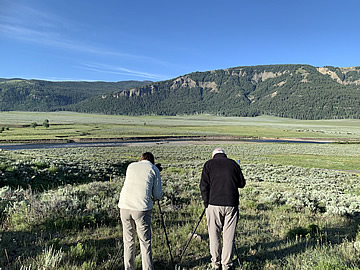
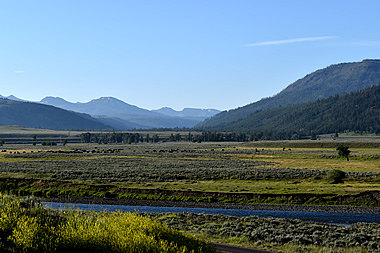
Lianna spotted a second grizzly in the distance - she was very good at spotting the animals! It was quite clear in the scope, with his humped back, foraging and digging in the ground.
We went on further east into the Lamar Valley, coming to huge herds of bison grazing on the lush grass. The males are in rut at this time of the year and aggressive, we could clearly hear the rumbling noise they make.
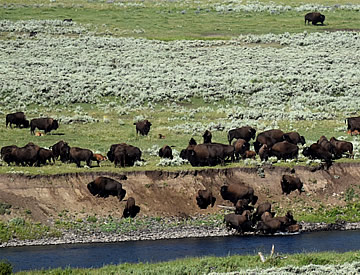
Five wolves were making their way west, on the far side of the river and we watched, totally fascinated, as they approached a herd of bison. There were several young bison calves and the wolves were probably looking to see if they could pick one off or attack a weak adult.
Watching the wolves interact with the bison was the highlight of an amazing morning with many high points. To see them approach the herd and adult bison charge them, the wolves circling round to try their luck on the other side - it was absolutely fascinating. In the main the adult bison were very aware that the wolves were around and watched them until they moved on.
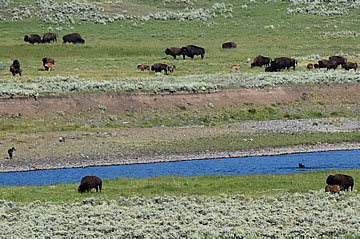
Lianna said there were a couple of yearling wolves who were learning how to hunt - one plunged into the river at one point, swam across, then sheepishly returned.
There was an obvious pack leader to this group of five wolves, who trotted ahead frequently looking back to check on the progress of the other four, as they followed in two pairs.
Wolves have it tough. Their average life span is only four or five years here in Yellowstone, surviving mainly on elk, though they do go after other wildlife such as the bison.
Grey wolves have been hunting in this area from time immemorial, but the gradual spread westward of man severely encroached on their territory as agriculture took hold of the landscape. This displaced the natural prey of the wolves, who then began to prey on the domestic livestock. The response was to kill the wolves and other predators such as bears, cougars and coyotes.
When Yellowstone was first established, in 1872, wolves continued to be killed, even though part of the park's remit was to protect the indigenous species; wolves were seen as wanton destroyers. In fact, by the mid 1900s wolves had been almost entirely eliminated from the 48 states.

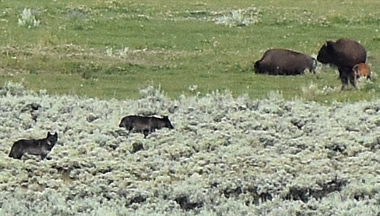
A survey in the 1970s found no evidence of wolves in the park but during the 1980s breeding packs began to reestablish in Montana and in 1997 10 wolves were relocated into Yellowstone.1 Radio collars are used for monitoring and research, never to locate wolves for public viewing.
We watched the wolves for a long time until they disappeared west then packed up and headed back down the road to pick them up again.

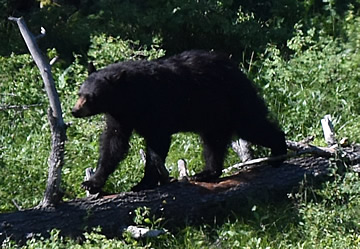
Unfortunately wolves have been listed then delisted many times from the endangered species list. As of April 26, 2017, "gray wolves are delisted in Montana, Idaho and Wyoming. Wolves are hunted in Idaho and Montana under state hunting regulations."1
We also spotted coyote, a bald eagle perched in the sun with his wings spread, and pronghorn which are not a true antelope but a survivor of a group of animals that evolved in North America over the past 20 million years.2 At this point we also had a very welcome and exceedingly good breakfast provided by Wolf Tracker: chocolate muffins, peanut butter nibbles, yogurts, strawberries, grapes, juice and coffee. The wolves had backed off much further away by this time so we continued west.
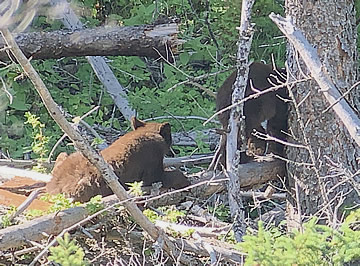
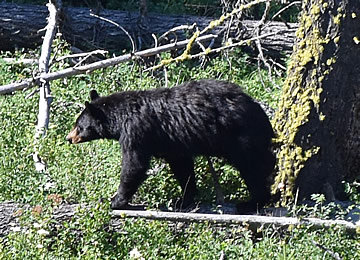
We came to a group of people by the road obviously watching something so we stopped and set up the scopes again. It was a large female adult bear and her two absolutely adorable cubs. The cubs were basically just mucking about having fun while the mother foraged in the surrounding area.
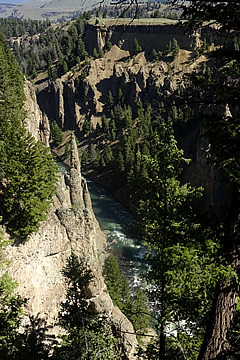
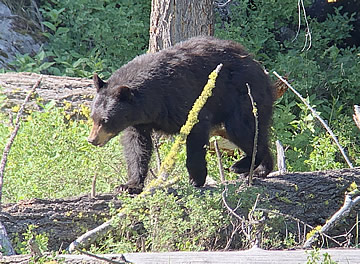
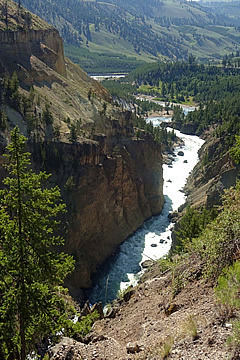
It was getting quite late in the morning now as we headed just south of the Calcite Springs area and an overlook down onto a stretch of the Yellowstone River called "The Narrows". Here there were several Rocky Mountain bighorn sheep - ewes and lambs - making themselves comfortable on a rock spur high over the river.
These animals are amazingly agile, able to keep a sure foot on the steepest of rock faces.
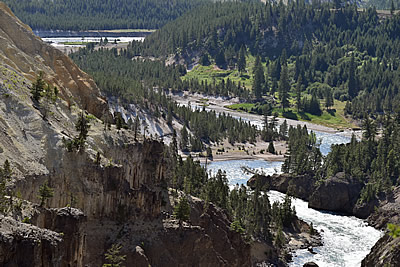
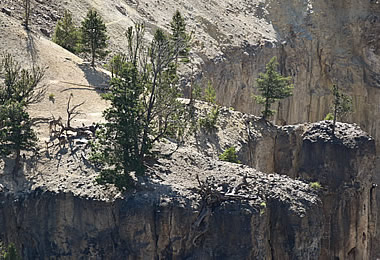
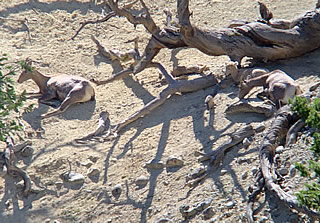
We got back into Gardiner at around mid-day, a spectacular morning we'll never forget.